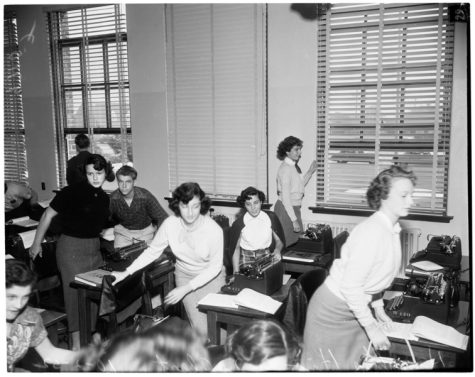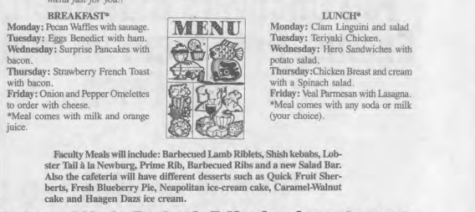Hami Then, Hami Now
May 8, 2023
92 years ago, Hamilton High School opened, unsuspecting of what they’d become: a historical treasure trove. Hamilton was home to many different types of people, even refugees of World War 2 who were reported by the school newspaper in 1941 to only know “hunger, and fear, and nazis’ brutalities.” Hami was as distinct then as it is now. Hamilton is and has always been a breeding ground for creativity and individuality, rightfully earning its title as “one of the most experimental and exciting schools in the Los Angeles system” by Times writer Skip Ferderber in 1970. But the abundant history and alumni aren’t the only proof of our distinctive student body; just think about the campus now. Walking around, you’ll see people from all kinds of backgrounds with all kinds of outfits. Sometimes, you’ll even see Spiderman around campus. For the alumni who get to watch the student body continue to evolve, and the students who get to take part in it, it is a privilege to be a part of Hamilton.
Current students get to see the legacies left behind from alumni and the traditions they created, from the collection of tiles decorating Brown hall’s foyer in recognition of the senior class since 1981 to the longstanding clubs former students created.
The Hamilton student body has “always been ahead of its time,” said BITA counselor Mr. Navas, who has seen the changes firsthand in almost 20 years at the school.
Many alumni appreciate their high school for their personal experience, not the school itself. However for some Hamilton alumni, it’s the school’s environment they are fond of. Described as a “creative melting pot” by 2008 Humanities graduate Taryn Boyd, Hamilton has created individuals with many different talents, careers, and passions, thanks to the influence of having a diverse and generally accepting student body. After all, the proof is in the pudding; just look at all the different kinds of alumni Hamilton has. From famous rappers like Nipsey Hussle to mayors like Karen Bass, every career is encouraged and every personality is welcome.
The Hamilton student body has been politically and socially progressive compared to other schools for years. Starting in 1978, when prejudice was normalized and accepted, Hamilton combatted it with a racially-accepting view, dedicated to closing the racial gap and educating students on race. Events such as multicultural fairs in the 70s took place to encourage what students argued for in the newspaper: “Students should be programmed into classes according to academic excellence, not race, creed, or color.” Faculty fought for this cause as well, introducing programs such as the CIS (currently integrated school) and SIS (student to student interaction) to reduce racial isolation.
This fight for equality carried on to gender. In 1985, Hamilton became one of the few schools to allow women to play on predominately male sports teams.
Ms. Boyd, reflecting on the difference between Hamilton and other schools at the time in 2006, said “At a time when same-sex relationships were frowned upon or simply banned at most schools, Hamilton administration allowed for same-sex couples to go to prom and homecoming. This was not the norm for schools when I was in high school.”
Hamilton students and staff prided themselves on holding values that were different from many at the time. Topics considered taboo in many places were openly discussed at Hamilton through opinions and questions that actively promoted open-mindedness. For example, in 1978, in an article debating whether or not homosexual people should be allowed to teach, students argued their beliefs. In their words, “We have no right to discriminate against any race or religion so why should we be allowed to discriminate against someone whose sexual habits deviate from the majority?” This value of acceptance is still openly encouraged at Hamilton to this day and it’s the reason many Hamilton students enjoy the school. The proof of this is in our longstanding club: we were one of the few schools with an active Latino Student Organization (La.S.O) and Black Student Union (BSU) then, now being the two clubs that have only continued to expand as years go by.
“I believe going to Hamilton had an overall positive impact on my life,” said Ms. Boyd. “I enjoyed going to a school with such a diverse student body. We accepted each other for who and what we were. There was not a lot of pressure to conform to social norms compared to other schools.”
Current student Serene Finamore, a sophomore in Humanities, said this is still the case. “I would say there’s still no pressure at all.”
Ms. Boyd is now currently a nail artist, and she claims her creative career path was further encouraged at Hamilton.
This value of acceptance is echoed by multiple other alumni, including Emilio Zapien, who said his justice-centered career path was influenced by his time at Hamilton in the Humanities program.
“I really appreciated, especially later in life, what it meant to go to school with a truly diverse student body,” Mr. Zapien said. “After learning about the true history of marginalized people in the United States, Hamilton inspired my career path to become a community organizer, prison and police abolitionist, and youth justice media strategist.” Zapien is Director of Media and Communications at the Youth Justice Coalition, a community-based non-profit organization working to end the school-to- prison pipeline and the criminalization of youth.
These alumni, although attending high school in different decades, described similar experiences to students today. Emilio Zapien said he was your average student: a good student, an athlete (captain of the varsity baseball team), and overall a smart kid, yet often in trouble for arguing with teachers and joking in class. Like many others, he struggled with underlying mental health issues. However, he found himself in his passion for justice. Former Hamilton teacher “Mr. Alan Kaplan really pushed us to think critically about how our society and culture shapes our thoughts and ideas about ourselves and our communities,” Mr. Zapien reflected. “It made me hungry to explore ideas of justice, freedom and liberation.”
Many alumni say that current Hamilton students get to enjoy a privilege students of the past were not rewarded: better academics. With more resources and a better curriculum, we have risen above previous academic limits.

In 1978, the proficiency and cheating rates were so high that every Hamilton student’s applications to any of the 8 UC campuses were simply refused. According to the president at the time whose name was withheld from the paper, “[the academics] are below satisfactory levels in required courses and are not of graduate school caliber.” This is not one of Hamilton’s proudest moments, but the academics have fortunately grown since then.
“It seems like the overall academic levels have improved over the years at Hami,” Mr. Zapien commented.
Despite having such a diverse and accepting school, we weren’t always as united. Prior to the establishment of our 5 SLCs, there were only three academies: the music academy, humanities, and the general school. Tensions between the community school and academies rose quickly considering the perceived unfairness and privileges in funding the academies had. Even now, students seem to feel Humanities students have more resources and success, after all, they do have a 100% graduation rate.
Mr. Navas said he initially believed this perception as well, but came to see it differently. “It’s not that they get extra benefits, their parents in general are more involved and that’s always been the case,” Mr. Navas explained. “They’re not given any more than the rest of us, but that’s just the perception.”
However, unlike before, we now have an SLC that fits everyone and their future career paths. From encouraging future artists in CAA to teaching future CEOs in BITA, Hamilton’s overall sense of community has grown from having a program that supports students’ specific needs.
Mr. Navas credits the school’s changes to teachers as well. “One thing I’m happy about is seeing now a lot more younger teachers,” he said. “There’s a lot of new, fresh thinking and the energy from the teachers is a positive shift, they are more proactive than we used to be. They fight for the kids a lot more.” Overall, though, Mr. Navas said he was glad to say that “things are more the same than they are different.”
Smaller changes have also influenced students’ experiences. School food is a common complaint of current students, and the menus of the past are sure to bring envy into the hearts of students.
Seeing the old Hamilton menu shocked SAS sophomore Brooklyn Harris. “It looks so much better than what we get now,” exclaimed Brooklyn. “It’s food I would actually go eat everyday.”

Sports have changed as well. When a soccer team was introduced to Hamilton, the student newspaper labeled it “reaching for new horizons” in the athletic department. It’s clear to see our sports department was previously fundamentally lacking a variety of sports. Now, that is not so much the case. We have a wide array of sports for every gender to choose from. From E-sports to flag football to drill team, Hamilton is constantly introducing new sports to ensure every student has a sport to play.
Of course some of the changes at Hamilton are simply due to the times. Take fashion, for example. If 1978 students truly hated Gucci, Louis Vuitton, “holey” pants, and dyed hair as they claimed in the student newspaper, they wouldn’t be able to stand glancing at the current student body.

Despite all that has changed, some things always stay the same. Since January 1978, bathrooms have had a reputation of being closed due to smoking and vandalism. Our reputation of having a large selection of creative, experimental classes is longstanding as well — Hamilton even previously offered graffiti classes. Fortunately, the things that make Hamilton so distinct are unlikely to change anytime soon. While we’ll soon be kissing our current campus goodbye to make room for the modernization project, students can trust the consistent values will not be destroyed along with the buildings.
Visit here to learn more about Hamilton’s history!
